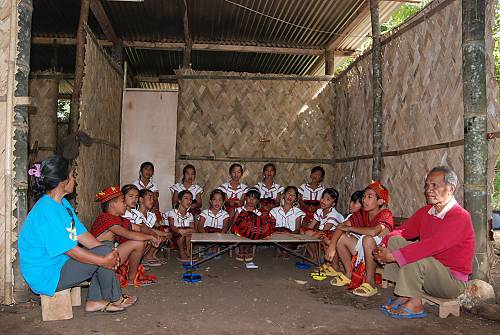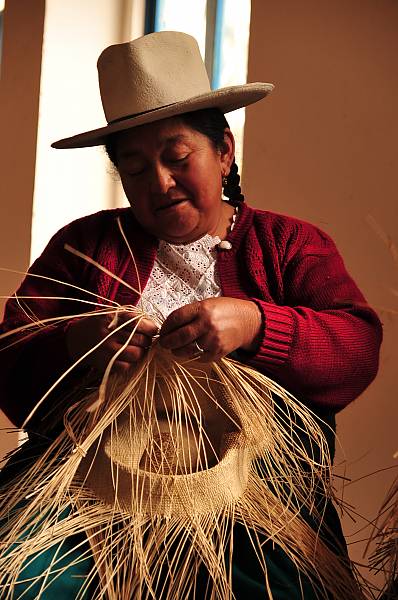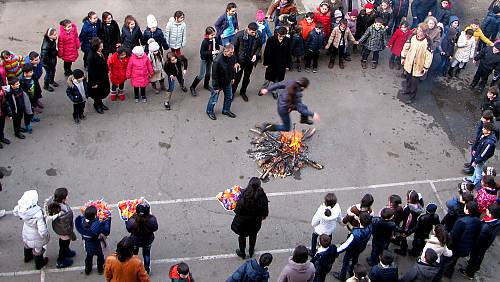The Committee requested (Decision 9.COM 5.a) a cumulative focus on measures taken by States Parties concerning transmission and education. This information has been produced in 2015 for its tenth session (ITH/15/10.COM/6.a: inglés|francés) and the content has been extracted on this page for broader consultation and visibility.
Click on concerned countries to read the full reports of submitted by States Parties.
Overview
Since education is often a devolved area of policy, it is not surprising to find a variety of administrative levels at which educational programmes are being offered from the Ministry of Education (national level) and regional authorities to municipalities (e.g. 415 municipalities are members of the Norwegian Council of Culture Schools which include teaching of crafts and other intangible heritage skills). At the non-state level, cultural associations (e.g. CHIPAWO in Zimbabwe that trains children in performing arts and teachers to teach and perform dances in schools) and non-governmental organisations active in the field of intangible heritage organise educational and training programmes. UNESCO is also active through its UNESCO Associated Schools (which, in Slovenia, have identified, explored and recorded local traditions) and ASPnet (UNESCO Associated Schools Project Network) that encourages safeguarding intangible cultural heritage as one of its main themes. The need for further research into how to integrate intangible cultural heritage into school curricula is also recognised, as in Burkina Faso where this has been done with partners in cultural communities. The UNESCO Regional Office in Bangkok has also developed a methodology for teaching it in schools, tested in two secondary schools in Uzbekistan, resulting in a Student’s Textbook and Teacher’s Handbook. In general, however, there is a shortage of resources and of teachers trained in teaching materials related to intangible cultural heritage (e.g. in Mozambique).
Measures by theme

© Fasnachts-Comité, 2015
In-school programmes are offered at different levels, with courses introduced into all schooling levels as in a Swiss canton where differentiated activities for 5 to 18 year-olds are offered to teachers, although the primary school level is the most common. One notable experience is in Viet Nam where intangible cultural heritage teaching has been integrated into several compulsory subjects so that water puppets, for example, are used to illustrate how things float, a đàn bầu – a mono-chord musical instrument used to explain sound waves, and a Vietnamese custom of chewing betel and areca demonstrates chemical reactions. A National Heritage education programme established for primary schools in Zimbabwe requires each school to set up a culture centre for the school and community.
In addition, a number of specific educational programmes are mentioned, including: the Cultural Rucksack (in Norway) that is a national lottery funded scheme to introduce all pupils from 6 to 19 years old to arts and culture, including intangible cultural heritage elements (e.g. the Sámi joik and duodji traditions); preparation of an educational ‘suitcase’ for primary schoolchildren in Belgium; and a Kit for Documentation of Intangible Heritage for use mainly in schools and museums’ educational departments and is available for free download from the National Inventory website in Portugal. Some such programmes explicitly solicit tradition bearers, as in ‘Tradition Bearers’ in Chile that aims to disseminate their knowledge and experiences to young people by creating spaces, developing strategies for classroom-based teaching and incorporating a workshop module into school hours; the Workshops with Tradition-bearers Project in Costa Rica to transmit knowledge to youth in schools; and a Heritage Project in Nicaragua where Cultural Classrooms have been set up using available spaces within existing schools where bearers transmit their knowledge and experiences to young people. As an extension activity, dance, food and traditional game workshops are organised in schools and diverse educational centres of the Dominican Republic. Some approaches go beyond the classroom, as in a programme in Brazil designed to promote intangible cultural heritage transversally with other disciplines, using pedagogic tools for introducing local heritage elements. In some cases as in Spain, teaching materials are made available online for teachers to access and Uruguay provides digital teaching tools through special portals and Internet-enabled laptops to schoolchildren.

© R.Rastrollo/NCCA-IHC, 2008
Beyond young people in general, the target audience includes specific groups such as indigenous peoples for whom dictionaries in four indigenous languages of the Amazon have been produced, to support the education of young people with their communities in their native languages (Ecuador). Similarly, Cote d’Ivoire has initiated the Integrated Schools project and teaches 11 provincial mother tongue languages in primary schools, with appropriate materials development while Honduras has introduced a contextual Intercultural Bilingual Education (IBE) course aimed at children of indigenous and African descent: this offers culturally appropriate curriculum content for indigenous children, as well as the mother language as the teaching medium. In southern Belize, three community high schools rely on indigenous bearers to teach children (e.g. in Maya communities they learn about Maya cosmology and how to play musical instruments) and indigenous communities in Kenya are involved in educational programmes on their intangible cultural heritage.
In certain cases, educational programmes and extra-curricular activities are built around specific elements, as in Slovenia where lace-making has been included in the primary school curriculum as an optional subject and afterschool activity, in Costa Rica where a main activity of the Safeguarding Action Plan for the ox-herding element was to create the ‘Travelling Oxcart’ educational suitcase and intergenerational encounters were set up for young ox-herders and, in Mozambique where an educational programme aims to integrate the Timbila and Nyau elements into local school curricula. Schools of Living Traditions in the Philippines represent an extra-curricular learning concept that ensures that young people and adults in the community learn indigenous knowledge and skills not integrated into the school curriculum. Re-enactments of the Petit Lumeçon form part of the teaching of primary schoolchildren in Belgium and a similar case is the inclusion of the Silbo Gomero (Whistling Language) element as an extra-curricular school activity on the island of La Gomera (Spain).
At the higher education level, intangible cultural heritage is often incorporated into university teaching and research in subject areas such as folklore, anthropology, sociology and history. As a general remark, in the periodic reports submitted between 2011–2014 higher educational programmes relating to intangible cultural heritage is frequently geared towards the practice and performance of intangible cultural heritage elements (music, dance, plastic arts etc.) and the teaching of research and fieldwork methodology to future cultural heritage management professionals. Universities may also integrate teaching about specific elements into their curricula and students are increasingly writing doctoral and masters theses on related topics. In some cases, specialised courses on intangible cultural heritage, either from a more anthropological or a heritage studies/management approach, have been established (e.g. in Bolivia). In the Dominican Republic, heritage bearers have instructed students on techniques for making traditional drums and carnival masks.
Another important aspect of educational programmes relates to education within the community where in-school courses are complemented by those offered by the non-formal education sector, for example in children’s clubs and culture centres. These may be provided by bearers, cultural associations, non-governmental organisations, educational institutions, libraries, museums and the national or regional heritage bodies. Several non-governmental centres in Zimbabwe offer education and training in different aspects of intangible cultural heritage within communities. In Namibia, cultural communities directly transmit their intangible heritage by participating in regular informal training workshops for young people and the Marimba Academy in Belize has four practitioner teachers. Development agencies and handicraft centres across Slovenia offer extra-curricular training for different target groups, including preschool and school groups, such as creative workshops, development projects with cultural heritage-related training and handicraft activities.
Many such educational programmes involve awareness-raising, information programmes and skills training aimed at the general public through various media ranging from community and local language radio to more formal, ‘classroom’ based settings. In some cases, training workshops related to elements are offered by the heritage agency in cooperation with the cultural communities, as with afro-descendants in the Dominican Republic; in others, community workshops have been organised to transmit skills and knowledge relating to handicrafts, music, traditional toys, medicine and foodways, nature and agriculture etc. (e.g. Costa Rica). In Slovenia, the art of bobbin lace-making is being transmitted through Third Age University courses and workshops for adults. In Nicaragua, cultural promoters are grouped into an association which puts in place training initiatives with local actors. Several different actors are involved in such training and transmission activities, including local community associations (Slovenia), non-governmental and civil society organisations (Portugal), amateur arts hobby groups (Uzbekistan) and peoples organisations and local government units (Philippines).

© Institut National du Patrimoine Culturel, 2011
Capacity-building aimed at developing the skills of practitioners and their ability to transmit their knowledge can also be a goal of such education, as in the Programme of Strategic Investigation in Bolivia to strengthen local capabilities for research and documentation. In Ethiopia, traditional women potters and community representatives have been trained to address their social and economic challenges and respond to market needs without abandoning their traditional skills. Craftsmen Houses have been set up in all administrative regions of Oman to train craftsmen, develop their practical skills and transmit them to young people. The Heritage Revival Academy in Hungary offers a 30-hour training programme specifically aimed at tradition bearers, providing guidance in identifying, collecting and utilising local intangible cultural heritage elements. Workshops on handicrafts, such as toquilla straw weaving in Ecuador, aim to improve skills in the sector for young people. In Norway, a vocational school has been set up for continuing education of craftsmen specialising in traditional building construction and restoration methods.
Finding appropriate physical spaces for such community-based education can prove a challenge and local town councils, museums and cultural centres often step in to provide support. For example, the Fandango Museum in Brazil, an outdoor community museum operating in five municipalities, includes houses of Fandango dancers, cultural centres and other spaces where this can take place. In Brazil, Heritage Houses have locally-tailored community educational programmes in intangible cultural heritage and the Community Cultural Centres in Bulgaria also provide such education and training. Museums have similar initiatives, such as the Intangible Cultural Heritage Applied Museum in Ankara (Turkey) which organises interactive training programmes and the Wayang Museum in Jakarta (Indonesia) which teaches the techniques of wayang – from making the puppets to performing with them.
Some reports have emphasised the need for non-formal means of transmission. The Tanchaz Movement in Hungary provides an example of transmitting folk dance in a non-formal manner close to traditional transmission. Indonesia has a well-established system of sanggar (traditional schools) that use traditional methods for transmitting a variety of intangible heritage elements. Festivals (held periodically and annually) and the performances during such events can also be an important means of non-formal transmission, as in Bulgaria and Burundi, where festivals such as the annual tambourine festival represent a means of strengthening non-formal transmission.
A combination of traditional oral transmission alongside modern educational methodologies has proven to be an effective transmission model in some cases. Modes of transmitting knowledge in Republic of Korea are twin-track, through the unofficial apprenticeship system and the public education system while, in the Democratic People’s Republic of Korea, there is an attempt to combine non-formal with formal means of transmission by involving research and educational institutions with individual bearers and practitioners at all levels. Both formal and non-formal transmission of intangible cultural heritage by leading practitioners by masters (e.g. gurus in India) is a common aspect of many expressions of intangible cultural heritage and this occurs informally within families, social groups and cultural communities and often through the medium of apprenticeship. Efforts made in Kyrgyzstan to support the traditional master-apprentice mode of transmission are also worthy of noting. Such transmission is not infrequently supported by Living Human Treasures and similar programmes in which heritage bearers are given formal recognition for their role in passing on their skills and knowledge.
However, formal schooling may also be seen to constitute a threat to traditional institutions and forms of transmission and, in Cote d’Ivoire, it is difficult for young people who attend school to learn from their elders, practitioners and bearers of traditional knowledge and know-how. As a response, communities themselves have begun to establish traditional ‘schools’ where they teach their traditional values and cultural skills and knowledge to the young, e.g. know-how related to the Gbofe tradition. It is worth noting here that, in Switzerland, a study on craftsmanship found a positive relationship between formal apprenticeship modes and degree of viability of the crafts studied.

© Tatev school, 2015
Such programmes may be viewed not simply as a means of informing the public about this heritage but also as having wider social and economic benefits. In Armenia, they are seen as a driver for socio-economic growth and quality vocational training (e.g. in handicrafts) is accessible for all social groups to alleviate poverty and inequality (especially for disabled people). An example is the School-Workshop Programme: Tools for Peace for student cooks in Colombia that includes the social goal of fighting against poverty. In Zimbabwe, young people are educated in skills related to intangible cultural heritage, such as the production of medicinal herbs and environmentally-sustainable permaculture methods as potential sources of income and employment. Training on the Timbila and Nyau elements in Mozambique is provided by community leaders to young people as a means of reducing the school dropout rate.
Education related to intangible cultural heritage also takes account of natural spaces and places of memory as in Colombia, where several programmes highlight the relationship between intangible heritage elements, community memory and the physical places where they are expressed. The draft heritage law in Georgia provides for the protection of natural spaces and places of memory and allows for protection zones for safeguarding places and landscapes important for their cultural values. Living heritage museums in Jordan provide a possible basis for establishing environmental museums related to intangible cultural heritage. Regional Natural Parks in Switzerland engage in educational and awareness-raising activities relating to intangible heritage and the natural environment (e.g. courses on yodelling), participatory activities relating to the countryside and environmental knowledge (e.g. agriculture) and guided thematic visits (e.g. craftsmanship). Awareness-raising in Cote d’Ivoire focuses on the importance of natural spaces (e.g. sacred forests) and resources (e.g. the Nangnranhanli plant for making the transverse trumpets of Gbofe) to intangible cultural heritage. In Ethiopia, the value of associated spaces for some elements, the Gudumale in Sidama where open spaces surrounded by indigenous trees and plants are needed to perform the Fiche ceremony, is promoted. Open air museums (e.g. in Slovakia), eco-museums (in Spain and Italy) and heritage trails (e.g. Cyprus) all contribute to education on the inter-linkage between intangible cultural heritage and the physical environment. It is worth noting that the Hudhud chants of the Ifugao (Philippines) inscribed on the Representative List relate to work in the Cordilleras Rice Terraces inscribed on the World Heritage List.